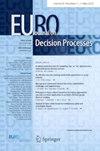Understanding tourists’ behavior toward transport mode choice by using machine learning methods
IF 2.1
Q3 MANAGEMENT
引用次数: 0
Abstract
Recently, transportation problems in evolving cities have become increasingly complex thus requiring innovative solutions. The complexity arises from the combination of urbanization, technological advancements, and diverse demographics. Therefore, integrating advanced methodologies, such as machine learning (ML), into transportation planning becomes essential. This study explores the application of ML techniques to predict and understand tourists’ transport mode choices when engaging in leisure activities. A comparative analysis of various ML algorithms including Neural Networks, k-Nearest Neighbor (k-NN), Naive Bayesian, Decision Tree, Support Vector Machines, Discriminant Analysis, and Ensembles reveals distinctive strengths and trade-offs. Based on the results, Neural Networks demonstrate high accuracy, precision, recall, and specificity, which makes the algorithm well-suited to predict transport mode choices. While k-NN exhibits competitive precision and recall, it struggles with specificity and indicates a higher false positive rate. These findings support transportation planners to select the most suitable algorithm according to the desired outcomes. The adoption of these advanced approaches enhances the understanding of travel behavior thus offering valuable tools for developing efficient urban transportation systems.
利用机器学习方法了解游客的交通方式选择行为
近来,不断发展的城市交通问题变得越来越复杂,因此需要创新的解决方案。这种复杂性源于城市化、技术进步和多样化人口结构的结合。因此,将机器学习(ML)等先进方法融入交通规划变得至关重要。本研究探讨了如何应用 ML 技术来预测和了解游客在从事休闲活动时的交通方式选择。通过对神经网络、k-近邻(k-NN)、Naive Bayesian、决策树、支持向量机、判别分析和集合等各种 ML 算法进行比较分析,我们发现了这些算法的独特优势和利弊权衡。根据结果,神经网络表现出较高的准确度、精确度、召回率和特异性,这使得该算法非常适合预测交通模式选择。虽然 k-NN 在精确度和召回率方面具有竞争力,但在特异性方面却很吃力,误报率也较高。这些发现有助于交通规划人员根据预期结果选择最合适的算法。采用这些先进的方法可以加深人们对出行行为的理解,从而为开发高效的城市交通系统提供有价值的工具。
本文章由计算机程序翻译,如有差异,请以英文原文为准。
求助全文
约1分钟内获得全文
求助全文

 求助内容:
求助内容: 应助结果提醒方式:
应助结果提醒方式:


